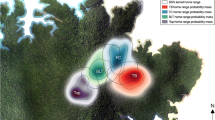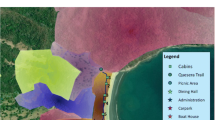Abstract
Capuchins rub particular plant materials into their pelage, a behavior for which most authors have proposed a medicinal function (Baker in American Journal of Primatology 38:263–270, 1996, Baker, M. (1998). Fur Rubbing as Evidence for Medicinal Plant Use by Capuchin Monkeys (Cebus capucinus): Ecological, Social, and Cognitive Aspects of the Behavior. Dissertation thesis. University of California Riverside; DeJoseph et al. in Journal of the American Academy of Dermatology 46:924–925, 2002). Individuals fur-rub solitarily or in groups, but researchers have not conducted studies to understand the differences. We investigated the link between the form of fur-rubbing and other social variables in 2 capuchin species. We supplied 2 captive groups —white-faced capuchins and tufted capuchins— with citrus fruit and onions and explored the behavioral processes and social aspects underlying the activity. We documented the occurrence, number of participants, and effect of recruitment behaviors in fur-rubbing subgroups. We investigated the role of kinship, affiliation, and dominance relationships in accounting for fur-rubbing groups. There is a significant difference in the form of fur-rubbing between white-faced and tufted capuchins. White-faced capuchins fur-rubbed mainly in subgroups and performed a particular behavior to recruit prospective participants, whereas tufted capuchins fur-rubbed mainly alone, and showed no particular motivation to be joined by other group members. White-faced capuchins could fur-rub together frequently, whatever their degree of kinship, affiliation, or dominance interval. In tufted capuchins, fur-rubbing appeared to be significantly affected by kinship and dominance.


Similar content being viewed by others
References
Altmann, J. (1974). Observational study of behaviour: Sampling methods. Behaviour, 49, 227–265.
Baker, M. (1996). Fur rubbing: Use of medicinal plants by capuchin monkeys (Cebus capucinus). American Journal of Primatology, 38, 263–270.
Baker, M. (1997). Identification and selection of fur rubbing materials by white-faced capuchin monkeys (Cebus capucinus). American Journal of Primatology, 42, 93.
Baker, M. (1998). Fur Rubbing as Evidence for Medicinal Plant Use by Capuchin Monkeys(Cebus capucinus): Ecological, Social, and Cognitive Aspects of the Behavior. Dissertationthesis.University of California Riverside.
Baker, M. (2000). Cognitive components of plant selection for fur rubbing in white-faced capuchin monkeys, Cebus capucinus. American Journal of Primatology, 51, 39–40.
Birkinshaw, C. R. (1999). Use of millipedes by black lemurs to anoint their bodies. Folia Primatologica, 70, 170–171.
Boinski, S. (1993). Vocal coordination of group movement among white-faced capuchin monkeys, Cebus capucinus. American Journal of Primatology, 30, 85–100.
Boinski, S., & Campbell, A. F. (1995). Use of trill vocalizations to coordinate troop movement among white-faced capuchins: A second field test. Behaviour, 132, 875–901.
Campbell, C. J. (2000). Fur rubbing behavior in free-ranging black-handed spider monkeys (Ateles geoffroyi) in Panama. American Journal of Primatology, 51, 205–208.
DeJoseph, M., Taylor, R. S. L., Baker, M., & Aregullin, M. (2002). Fur-rubbing behaviour of capuchin monkeys. Journal of the American Academy of Dermatology, 46, 924–925.
de Vries, H. (1995). An improved test of linearity in dominance hierarchies containing unknown or tied relationships. Animal Behavior, 50, 1375–1389.
de Vries, H., Netto, W. J., & Hanegraaf, P. L. H. (1993). Matman: A program for the analysis of sociometric matrices and behavioural transition matrices. Behaviour, 125, 157–175.
de Waal, F. B. M. (1991). Rank distance as a central feature of rhesus monkey social organization: A sociometric analysis. Animal Behavior, 41, 383–395.
de Waal, F. B. M., & Luttrell, L. M. (1986). The similarity principle underlying social bonding among female rhesus monkeys. Folia Primatologica, 46, 215–234.
Di Bitetti, M. S. (1997). Evidence for an important social role of allogrooming in a Platyrrhine primate. Animal Behavior, 54, 189–211.
Evans, S., Weldon, P., Giovanetti, J., Moody, C., & Vicaria, E. (2004). Anointing in owl monkeys. Folia Primatologica, 75, 259.
Falotico, T., Verderane, M. P., Resende, B. D., Labruna, M. B., Izar, P., & Ottoni, E. B. (2004). Anting in a semi-free ranging group of brown capuchin monkeys (Cebus apella). Folia Primatologica, 75, 372.
Fedigan, L. M. (1993). Sex differences and intersexual relations in adult white-faced capuchins, Cebus capucinus. International Journal of Primatology, 14, 853–877.
Fragaszy, D. M., Visalberghi, E., & Fedigan, L. M. (2004). The Complete Capuchin: The Biology of the Genus Cebus. Cambridge University Press, Cambridge, UK.
Groves, C. P. (2001). Primate Taxonomy. Smithsonian Institution Press, Washington, D.C.
Huffman, M. A., Page, J. E., Sukhdeo, M. V. K., Gotoh, S., Kalunde, M. S., Chandrasiri, T., et al. (1996). Leaf-swallowing by chimpanzees: A behavioral adaptation for the control of strongyle nematode infections. International Journal of Primatology, 17, 475–503.
Izawa, K. (1980). Social behavior of the wild black-capped capuchin (Cebus apella). Primates, 21, 443–467.
Jack, K. M. (2003). Explaining variation in affiliative relationships among male white-faced capuchins (Cebus capucinus). Folia Primatologica, 74, 1–16.
Janson, C. H. (1985). Aggressive competition and individual food consumption in wild brown capuchin monkeys (Cebus apella). Behavioral Ecology and Sociobiology, 18, 125–138.
Janson, C. H. (1986a). The mating system as a determinant of social evolution in capuchin monkeys (Cebus). In J. G. Else, & P. C. Lee (Eds.), Primate Ecology and Conservation (pp. 169–179). Cambridge University Press, Cambridge, UK.
Janson, C. H. (1986b). Capuchin counterpoint: Divergent mating and feeding habits distinguish two closely related monkey species of the Peruvian forest. Natural History, 95, 45–52.
Janson, C. H. (1990). Social correlates of individual spatial choice in foraging groups of brown capuchin monkeys, Cebus apella. Animal Behavior, 40, 910–921.
Leca, J.-B., Fornasieri, I., & Petit, O. (2002). Aggression and reconciliation in Cebus capucinus. International Journal of Primatology, 23, 979–998.
Leca, J.-B., Gunst, N, Thierry, B., & Petit, O. (2003). Distributed leadership in semi-free ranging white-faced capuchin monkeys. Animal Behavior, 66, 1045–1052.
Longino, J. T. (1984). True anting by the capuchin, Cebus capucinus. Primates, 25, 243–245.
Ludes, E., & Anderson, J. R. (1995). Peat-bathing by captive white-faced capuchin monkeys, Cebus capucinus. Folia Primatologica, 65, 38–42.
McGrew, W. C., & Tutin, C. E. G. (1978). Evidence for a social custom in wild chimpanzees? Man, 13, 243–251.
Panger, M. A., Perry, S., Rose, L., Gros-Louis, J., Vogel, E., McKinnon, K. C., et al. (2002). Cross-site differences in foraging behavior of white-faced capuchins (Cebus capucinus). American Journal of Physical Anthropology, 119, 52–66.
Parr, L. A., Matheson, M. D., Bernstein, I. S., & de Waal, F. B. M. (1997). Grooming down the hierarchy: Allogrooming in captive brown capuchin monkeys, Cebus apella. Animal Behavior, 54, 361–367.
Perry, S. (1996). Female-female social relationships in wild white-faced capuchin monkeys, Cebus capucinus. American Journal of Primatology, 40, 167–182.
Perry, S. (1998). A case report of male rank reversal in a group of wild white-faced capuchins (Cebus capucinus). Primates, 39, 51–69.
Perry, S., Baker, M., Fedigan, L., Gros-Louis, J., Jack, K., McKinnon, K. C., et al. (2003). Social conventions in wild white-faced capuchin monkeys. Current Anthropology, 44, 241–268.
Perry, S., & Rose, L. M. (1994). Begging and transfer of coati meat by white-faced capuchin monkeys. Cebus capucinus. Primates, 35, 409–415.
Petit, O., Abegg, C., & Thierry, B. (1997). A comparative study of aggression and conciliation in three Cercopithecine monkeys (Macaca fuscata, Macaca nigra, Papio papio). Behaviour, 134, 415–432.
Petit, O., Desportes, C., & Thierry, B. (1992). Differential probability of “coproduction” in two species of macaque (Macaca tonkeana, M. mulatta). Ethology, 90, 107–120.
Phillips, K. A. (1995). Resource patch size and flexible foraging in white-faced capuchins (Cebus capucinus). International Journal of Primatology, 16, 509–519.
Quinn, J. P. (2004). Fur Rubbing Behavior in a Captive Group of Cebus apella apella Monkeys. Master’s thesis. California State University, Fullerton.
Rose, L. M. (1994). Sex differences in diet and foraging behavior in white-faced capuchins (Cebus capucinus). International Journal of Primatology, 15, 95–114.
Rose, L. M. (1997). Vertebrate predation and food-sharing in Pan and Cebus. International Journal of Primatology, 18, 727–765.
Thierry, B. (1990). Feedback loop between kinship and dominance: The macaque model. Journal of Theoretical Biology, 145, 511–521.
Thierry, B. (2000). Covariation of conflict management patterns in macaque societies. In F. Aureli, & F. B. M. de Waal (Eds.), Natural Conflict Resolution (pp. 106–128). University of California Press, Berkeley.
Thierry, B. (2004). Social epigenesis. In B. Thierry, M. Singh, & W. Kaummans (Eds.), Macaque societies: A model for the study of social organization (pp. 267–294). Cambridge University Press.
Thierry, B., Aureli, F., de Waal, F. B. M., & Petit, O. (1997). Variation in reconciliation patterns and social organization across nine species of macaques. Advances in Ethology, 32, 39.
Ueno, Y. (1991). Urine-washing in tufted capuchins (Cebus apella): Discrimination between groups by urine-odor. In A. Ehara, T. Kimura, O. Takenaka, & M. Iwamonto (Eds.) (pp. 297–300). Primatology today. Elsevier, Amsterdam.
Valderrama, X., Robinson, J. G., Attygale, A. B., & Eisner, T. (2000). Seasonal anointment with millipedes in a wild primate: A chemical defense against insects? Journal of Chemical Ecology, 26, 2781–2790.
van Schaik, C. P., & van Noordwijk, M. A. (1989). The special role of male Cebus monkeys in predation avoidance and its effect on group composition. Behavioral Ecology and Sociobiology, 24, 265–276.
Verbeek, P., & de Waal, F. B. M. (1997). Post-conflict behavior of captive brown capuchins in the presence and absence of attractive food. International Journal of Primatology, 18, 703–725.
Welker, C., Hoehmann, H., & Schaefer-Witt, C. (1990). Significance of kin relations and individual preferences in the social behavior of Cebus apella. Folia Primatologica, 54, 166–170.
Zahavi, A. (1977). The testing of a bond. Animal Behavior, 25, 246–247.
Zito, M., Evans, S., & Weldon, P. J. (2003). Owl monkeys (Aotus spp.) self-anoint with plants and millipedes. Folia Primatologica, 74, 159–161.
Acknowledgments
A fellowship from the Ministère de l’Education Nationale, de la Recherche, et de la Technologie supported the work. During the preparation of the manuscript, a Lavoisier grant, Ministry of Foreign Affairs, France supported J.-B. Leca; a grant from the National Science Foundation (BCS-0352035) supported N. Gunst. We thank Camille Chandès, Sandra Colas, Nadia Daki, Pavine Lefebvre, Hélène Meunier, and Delphine Penant for occasional assistance in data collection. We also thank Michael A. Huffman for his fruitful suggestions, and 2 anonymous reviewers for their very constructive comments on previous versions of the manuscript. We thank Sue Boinski and Josephine P. Quinn for providing valuable information and Ana M. Ducoing for correcting the English.
Author information
Authors and Affiliations
Corresponding author
Rights and permissions
About this article
Cite this article
Leca, JB., Gunst, N. & Petit, O. Social Aspects of Fur-rubbing in Cebus capucinus and C. apella . Int J Primatol 28, 801–817 (2007). https://doi.org/10.1007/s10764-007-9162-4
Received:
Revised:
Accepted:
Published:
Issue Date:
DOI: https://doi.org/10.1007/s10764-007-9162-4




